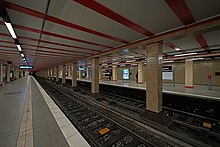Berlin Nordbahnhof
| Bf | ||||||||||||||||||||||||||
 S-Bahnhof Nordbahnhof | ||||||||||||||||||||||||||
| Location | Mitte, Berlin, Berlin Germany | |||||||||||||||||||||||||
| Platforms | 2 island platforms | |||||||||||||||||||||||||
| Tracks | 4 | |||||||||||||||||||||||||
| Train operators | S-Bahn Berlin | |||||||||||||||||||||||||
| Connections | ||||||||||||||||||||||||||
| Other information | ||||||||||||||||||||||||||
| Station code | 532 | |||||||||||||||||||||||||
| DS100 code | BNB[1] | |||||||||||||||||||||||||
| IBNR | 8089024 | |||||||||||||||||||||||||
| Category | 4[2] | |||||||||||||||||||||||||
| Fare zone | VBB: Berlin A/5555[3] | |||||||||||||||||||||||||
| Website | www.bahnhof.de | |||||||||||||||||||||||||
| Services | ||||||||||||||||||||||||||
| ||||||||||||||||||||||||||
 | ||||||||||||||||||||||||||
| Location | ||||||||||||||||||||||||||
 Berlin Nordbahnhof (Berlin Stettiner Bahnhof) Location within Berlin | ||||||||||||||||||||||||||

Berlin Nordbahnhof (formerly Stettiner Bahnhof) is a railway station in the Mitte district of Berlin, Germany. It is served by the Berlin S-Bahn and local bus and tram lines.
History[]



In 1842, the Stettiner Bahnhof opened as terminus of the railway line to then German city of Stettin (Polish: Szczecin, since 1945 a part of Poland), connecting Berlin with the Stettin sea port, later also important for reaching the holiday resorts on the Baltic Sea (so-called Pomerania Riviera or more colloquial Berliners' bath tub). As the number of passengers increased rapidly, the station on Invalidenstraße became one of Berlin's busiest railway termini and had to be enlarged several times.
1877, the Stettiner Bahnhof also became the Berlin passenger train terminus of the Preußische Nordbahn (Prussian Northern Railway) to Stralsund via Neu-Strelitz, and later also to Rostock.
A special suburban station was built to the west of the mainline terminal, serving three suburban lines, to Bernau on the Berlin-Stettin railway, to Oranienburg on the North Railway, and to Velten via Berlin-Tegel on the Kremmen Railway.
In 1939, these three suburban lines were paired with the three southern suburban lines to form three transversal lines, by means of the North-South S-Bahn link with a tunnel from Stettiner Bahnhof to Anhalter Bahnhof under the Berlin city centre. As part of opening of the first phase, the northern section, the present-day underground station of the S-Bahn opened on 28 May 1936. The new underground station replaced the former suburban railway station, whose railhead building can still be seen west of the Nordbahnhof on Zinnowitzer Straße. The new, underground, S-Bahn station was located East of the main building, with the tracks crossing from the west to the east under the approaches of the mainline tracks.
On 25 April 1945 the S-Bahn ceased operation due to the Soviet invasion, which had reached Berlin's suburbia on 21 April. Most likely on 2 May 1945 the SS exploded the tunnel ceiling under Landwehrkanal, which caused the subsequent flooding of the tunnel. After World War II the station itself was within the Soviet sector (East Berlin). After drainage and repair the tunnel and its stations reopened for traffic in November 1947.

On 1 December 1950, the name of the formerly German town of Stettin was deleted by a renaming into Berlin Nordbahnhof. Since the rail lines leading to the station crossed the territories of West Berlin, it was closed by the GDR authorities on 18 May 1952 and finally demolished in 1962. The adjacent S-Bahn station remained under the name of Nordbahnhof. During the Uprising of 1953 in East Germany and East Berlin the S-Bahn, operated by the eastern Deutsche Reichsbahn, interrupted traffic between 17 June and 9 July 1953.
Between 13 August 1961, the day the Berlin Wall went up, and 1 September 1990 trains did not stop at the station, because it was located in East Berlin. Nevertheless, the Reichsbahn continued to operate the line to connect the stations in the northern and southern areas of West Berlin. Trains only stopped in the stations with entrances in West Berlin, and when they passed through the East Berlin stations passengers viewed from the train windows the empty and barely lit platforms of so-called ghost stations, where time had stood still since 13 August 1961.
All entrances were closed until the station reopened on 1 September 1990. Soon after, the station closed again for extensive refurbishment lasting one and a half years. The tunnel and station reopened on 1 March 1992. The Nordbahnhof entrance hall was restored in 2006, including a new layout of the forecourt with indicated tracks and inset plaques bearing the destinations of the former trains to the Baltic coast and an exhibition near the platforms describing the era of the "ghost stations".
References[]
- ^ Eisenbahnatlas Deutschland (German railway atlas) (2009/2010 ed.). Schweers + Wall. 2009. ISBN 978-3-89494-139-0.
- ^ "Stationspreisliste 2021" [Station price list 2021] (PDF) (in German). DB Station&Service. 16 November 2020. Retrieved 3 December 2020.
- ^ "Der VBB-Tarif: Aufteilung des Verbundgebietes in Tarifwaben und Tarifbereiche" (PDF). Verkehrsbetrieb Potsdam. Verkehrsverbund Berlin-Brandenburg. 1 January 2017. Archived from the original (PDF) on 27 October 2020. Retrieved 25 November 2019.
External links[]
- Station information (in German)
Coordinates: 52°31′55″N 13°23′16″E / 52.53194°N 13.38778°E
- Berlin S-Bahn stations
- Railway stations in Berlin
- Railway stations located underground in Germany
- Buildings and structures in Mitte
- Railway stations in Germany opened in 1842
- Railway stations closed in 1961
- Railway stations in Germany opened in 1990
